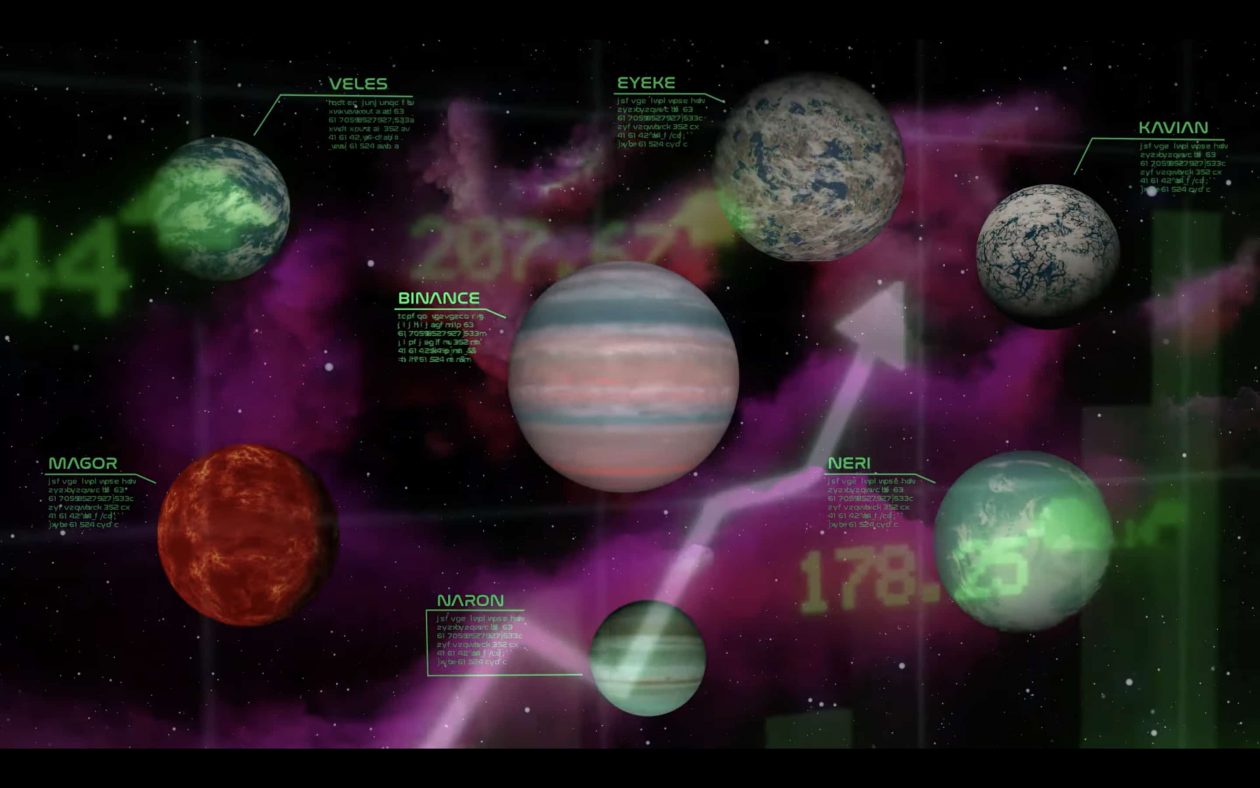Blockchain games are on the rise. One of the most popular at the moment is Alien Worlds, a play-to-earn game where players explore the seven planets in the metaverse and earn by mining digital assets, battling other explorers and from rental commission from the land they own. Players can collect unique digital land, tools and avatars such as an Artunian Shovel tool for mining or Stealth Mercenary avatar to send into battle. More than 2.1 million people have joined the Alien Worlds blockchain game since its launch in December, making it the biggest blockchain game in terms of daily active wallets.
Alien Worlds is a decentralized finance (DeFi) non-fungible token (NFT) metaverse on the Ethereum, WAX and BSC blockchains and players compete using NFTs — a unique digital asset whose authenticity and ownership is tracked on a blockchain — and earn Trilium (TLM), the in-game currency. In the game, Trilium is required to control competing Decentralized Autonomous Organizations (DAOs), known as Planet DAOs.
Sarojini McKenna, Alien Worlds’ co-founder, told Forkast.News in an interview that blockchain play-to-earn gaming, metaverses and DAOs will likely only continue to grow in popularity.
“More of what we enjoy, more of what we give value to, possibly more of how we earn our livelihoods, will all be happening inside of the metaverse,” said McKenna, who is based in Zug, Switzerland. “And once that happens, our interest goes there, and you could say that we’re living there.”
McKenna has bridged traditional business practices with decentralized communities and concepts since the early days of DAOs. Prior to founding Alien Worlds, she was an M&A banker at Rothschild and a private equity consultant. She was a founding board member of the DAC Foundation, which aims to empower people and reduce corruption through decentralized autonomous organizations.

The following Forkast.News interview with McKenna has been edited and condensed.
What does the term ‘metaverse’ mean to you?
I think of a metaverse as an abstraction of reality in the digital realm — bringing something about real-life into our digital life. What has been done so far is a lot of virtual reality (VR) metaverses where you go in, they’re beautifully constructed, you have an avatar and you can see different things as you take steps and walk around. That’s interesting and very worthwhile tech to be building out, but it’s not what we’re trying to do. What we’re trying to replicate is relationships between people — groups coming together to form collaborative units and compete with other groups.
What are some of the trends or developments that you’re seeing in the metaverses and NFTs space?
More and more of our economic activity is going to move inside of that paradigm. Real-world things will be represented on the blockchain and it’s just going to be more of everything happening there, including even our jobs eventually, what we produce, our creative output. We’ve already been seeing artists and so on. Children could sort of go to school inside of a metaverse to an extent in addition to real-world schools. They could do math drills inside of a metaverse and then have non-fungible tokens that give them a badge, and their parents can check that they’ve done it. More of our lives are just going to happen there.
How did Alien Worlds come about?
The idea came because we have been building DAOs since 2018 and we wanted to bring DAOs to more people. My co-founder, Rob Allen, also saw that NFTs were such a natural use case for blockchain technology and he was interested in the Wax blockchain from really early on, which is where we located our NFTs and gaming logic. So it was a combination of everything that we’d been doing with DAOs and NFTs. We started designing it probably 18 months to two years ago and we created Trilium and did the first Trilium transaction just over a year ago. The game economy started at the end of December and that’s when we began the mining functionality.
It takes a long time and a lot of investment to build out a proper VR environment, whereas we were able to put a fungible token out there, a series of NFTs and some DAOs, each of which is just a blockchain structure. It was quicker to market because we chose blockchain elements that you could get out there within a year. And unlike other metaverses where the environment takes time to build out, we gave people NFTs, Trilium and the DAO structure, which abstract what we have in our real lives — we all use money, have objects in our lives which are like NFTs and we form units of competitive and collaborative organization, like companies or groups. These are very natural things for human beings to be interacting with and it didn’t take much of a leap of imagination for people.
I was amazed at how quickly they started to create these competitions between each other with mining. And it’s because human beings naturally love to play and compete.
Could you describe how the different elements in Alien Worlds seem to embody aspects of the crypto ecosystem?
Every element describes or abstracts a particular aspect of what crypto is all about. We have a fungible token — Trilium — that allows the metaverse to track value in a very liquid way, which is what tangible tokens can do. We have NFTs, which are unique crypto assets, and they have a different function because they allow people to select particular attributes that they want to use in the gameplay.
We have the concept of mining, which is again a native crypto concept. When people mine Trilium, they’re doing a proof-of-work calculation or they’re supplying that solution. It is impossible for the average person to become a proof-of-work Bitcoin miner today, but you can come onto our game and proof-of-work mine a cryptocurrency and you can see that you’re doing that on the blockchain. We have the governance, the DAOs, which again, is a very blockchain concept.
Some people are getting a bit of an education in crypto through the game as well and in blockchain, how blockchain tech works, because they can see the NFTs arriving in their inventory. Actually, our product is buggy enough that people can’t always see things instantly and we have other community members saying, ‘No, no, you have received it. Don’t worry, it just hasn’t appeared in your inventory. You can find that on a block explorer.’
We didn’t fully conceive that way but people have commented that we’ve created a whole blockchain metaverse where every element connects through to either the history or the future of blockchain tech and allows people to play and interact with them.
Decentralized Autonomous Organizations (DAOs) are a key feature of the game. What are DAOs and how do they work?
We’ve been working on DAOs pretty much nonstop since 2018. If we think of cryptocurrency as decentralized money, DAOs are decentralized and organized social organizations or organizations of human activity tracked by a token.
The token functions as the unit of exchange and gives you voting power in the DAO. It’s an interesting combination of value and power. In a DAO structure, everyone has the voting power of the number of tokens that they hold. One of the reasons why you need to have that in a blockchain structure is because people with more stake are actually securing the system. If you have a DAO that has a very low market cap, it’s very cheap to take it over. If you have a DAO with a big market cap, it’s much more expensive to take it over and you could think of that as being more secure.
DAOs are a very natural native blockchain structure for organizing human activity and that’s why as crypto grows, DAOs will grow with it.
Alien Worlds runs on the Ethereum, WAX and the Binance Smart Chain (BSC) blockchains. What was some of the thinking behind using these blockchains?
We were familiar with Wax and it’s very easy to make DAO structures through that because there are certain multisignature permissions that are quite well designed there. A DAO is like a series of multisignature permissions that can govern various transactions, so it was a good codebase to use. The DAOs and the Trilium you earn through the game is on Wax.
We want to put assets and functionality on the chain that is best for users and that the user would most expect basically. Ultimately, we have this invisible blockchain aspiration where the user shouldn’t really be all that aware of the blockchain underpinning it. We have our token Trilium on Ethereum, because people have a lot of trust that it’s a huge chain, and if what you mainly want to do is store a high-value token or asset, it’s a good chain for that. We will in time have higher value collectible NFTs there.
Putting the token on the Binance Smart Chain (BSC) was a consumer choice to reach a bigger audience, because BSC is becoming a more consumer-centric chain and a lot cheaper than Ethereum to transact. When people earn Trilium through the Planet Binance game, they will be earning the BSC-based one.
Trilium exists across multiple chains and users can teleport their Trilium tokens between BSC, WAX and Ethereum. When you teleport tokens from one chain to the other, it takes them out of the accessible balance on the chain that you’re going to, and it puts them back into the accessible balance on the chain that you’re taking it from so you get a token on the other chain and you lose the token on the previous chain.
Has the bubble burst for NFTs?
There are things that look like bubbles bursting, but what that is, is the tech moving on. The tech around NFTs in the last couple of years has only enabled them to be collectibles and you couldn’t build a lot of utility in. So maybe a certain bubble will burst around collectibles-only NFTs as now we’re able to build functionality into NFTs and maybe people will enjoy NFTs that have both collectible and utility value.
I don’t see the concept of unique items being represented on the blockchain as being something that’s going to go away because it’s so useful — we were able to put human organization on chain through the DAOs, individual items on chain through NFTs, and the tracker of staked power reward on chain as the fungible token. That’s a really useful way of being able to abstract what’s going on in our lives on chain.
This is still very early. One day we’ll look back and just laugh at how quaint it was. But we have to go through these days to get to the future.





